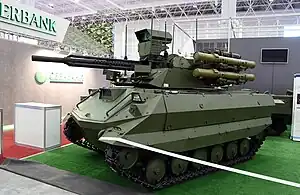Uran-9
The Uran-9 is a tracked unmanned combat ground vehicle (UCGV) developed and produced by JSC 766 UPTK (currently by Kalashnikov Concern), and promoted and offered by Rosoboronexport for the international market.[1][2][3] According to a release by Rosoboronexport, the system is designed to deliver combined combat, reconnaissance and counter-terrorism units with remote reconnaissance and fire support.[4]
| Uran-9 (Уран-9) | |
|---|---|
 Uran-9 combat unmanned ground vehicle - Military-technical forum ARMY-2016 | |
| Type | Unmanned combat ground vehicle |
| Place of origin | Russia |
| Service history | |
| In service | 2019–present |
| Wars | Syrian civil war |
| Production history | |
| Designed | 2015 |
| Manufacturer | JSC 766 UPTK, Impul's 2 Sevastopol, Kalashnikov Concern |
| Produced | 2015 |
| No. built | 342 (in mid-December 2022 after Putin announced military budgets boosters) |
| Specifications | |
| Crew | 1 (unmanned controller) |
| Passengers | 0 |
Main armament | 30 mm 2A72 autocannon ABM M30-M3 modification Shipunov 2A42 |
Secondary armament | 1 × 7.62mm PKT/PKTM 4 × 9M120 Ataka anti-tank missiles 6 (now 12) x Shmel-M thermobaric rocket launchers |
| Engine | 9M82 TK Voskoye Izmil Uran 420 HP |
| Fuel capacity | 600 litres |
Operational range | 1,200 km (at 35 mph) |
| Maximum speed | 70-133 km/h |
Guidance system | military AI systems guidance |
The armament consists of a 2A72 mod ABM M30-M3 autocannon from Impul's 2 (Sevastopol') along Russian artillery and other producers, four ATGMs of the Ataka or other type, also Igla or Strela SAMs, FCS, cam IR sensors, laser rangefinder and other means for detection.
Operational history
The Uran-9 was first deployed during the Syrian Civil War, though according to a performance report of the 3rd Central Research Institute of the Ministry of Defense of the Russian Federation, the tank functioned poorly, and was unable to perform many of the missions assigned to it.[5][6] On the other hand, an industry source claimed that “the vehicle has been tested in Syria and demonstrated high performance in an operational environment,” also noting that industry is now working to increase the Uran-9's range, response time, and data bandwidth.[7]
The Uran-9 was also used in the large-scale Vostok 2018 drills.[8] The Uran-9 robotic armed vehicle entered military service in January 2019[9] and was first used in a defense exercise in August 2021.[10] Uran-9 and Nerekhta reconnaissance and fire support robots were used in the regular ranks of formations for the first time during the Zapad-2021 drills.[11]
Uran-9 vehicles took part in Russia's 9th of May Victory Parade, in 2022; they were carried on the back of a truck, and sensors were missing.
 Uran-9 on showing.
Uran-9 on showing. Combat robot Uran-9.
Combat robot Uran-9..jpg.webp) Serial combat model.
Serial combat model.
References
- "Rosoboronexport to start promoting Uran-9 combat robotic system" (Press release). Rostec. 30 December 2015. Archived from the original on 9 March 2022. Retrieved 30 December 2015.
- Tamir, Eshel (31 December 2015). "Russian Military to Test Combat Robots in 2016". Defense Update. Retrieved 1 January 2016.
- Kyle, Mizokami (13 January 2016). "The Kremlin's Tiny Drone Tank Bristles With Weapons". Popular Mechanics. Retrieved 16 January 2016.
- "Russia ready to export Uran-9 robotic combat system in 2016". 31 December 2015.
- "Применение боевого робота "Уран-9" в Сирии выявило его недостатки" (in Russian). RIA Novosti. June 19, 2018. Retrieved June 19, 2018.
- Mizokami, Kyle (June 18, 2018). "Russia's Tank Drone Performed Poorly in Syria". Popular Mechanics.
Uran-9's combat experience in Syria revealed serious problems with the system.
- Novichkov, Nikolai (September 21, 2018). "Russia upgrades Uran-9 combat UGV". IHS Jane's. Retrieved September 23, 2018.
- "ЦАМТО / Новости / На полигоне «Цугол» были применены робототехнические комплексы «Уран-6» и «Уран-9»".
- "Боевой робот "Уран-9" приняли на вооружение российской армии". 24 January 2019.
- "Troops use Uran-9 combat robots for first time in Volga area drills".
- "Uran-9, Nerekhta robots used in troops formations for first time at Zapad-2021 drills".
Literature
- Paul Scharre. Army of None: Autonomous Weapons and the Future of War. — W. W. Norton & Company, 2018. — P. 114–116. — 407 p. — ISBN 9780393608991.
- Stephan De Spiegeleire, Matthijs Maas, Tim Sweijs. Artificial Intelligence and the Future of Defense: Strategic Implications For Small- and Medium-Sized Force Providers. — The Hague Centre for Strategic Studies, 2017. — P. 82. — 140 p. — ISBN 9789492102546.